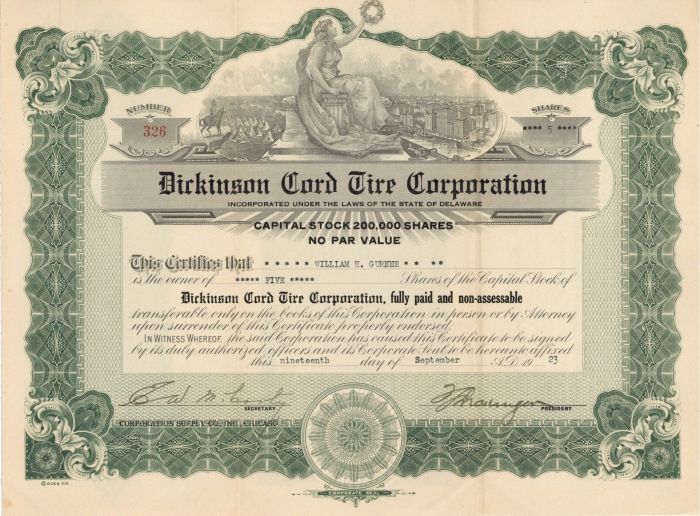Dickinson Cord Tire Corporation - Stock Certificate
Inv# AS1349 Stock
Stock printed by Goes.
The earliest tires were bands of leather, then iron (later steel) placed on wooden wheels used on carts and wagons. A skilled worker, known as a wheelwright, would cause the tire to expand by heating it in a forge fire, place it over the wheel and quench it, causing the metal to contract back to its original size so that it would fit tightly on the wheel.
The first patent for what appears to be a standard pneumatic tire appeared in 1847 lodged by Scottish inventor Robert William Thomson. However, this never went into production. The first practical pneumatic tire was made in 1888 on May Street, Belfast, by Scots-born John Boyd Dunlop, owner of one of Ireland's most prosperous veterinary practices. It was an effort to prevent the headaches of his 10-year-old son Johnnie, while riding his tricycle on rough pavements. His doctor, John, later Sir John Fagan, had prescribed cycling as an exercise for the boy, and was a regular visitor. Fagan participated in designing the first pneumatic tires. Cyclist Willie Hume demonstrated the supremacy of Dunlop's tires in 1889, winning the tire's first-ever races in Ireland and then England. In Dunlop's tire patent specification dated 31 October 1888, his interest is only in its use in cycles and light vehicles. In September 1890, he was made aware of an earlier development but the company kept the information to itself.
In 1892, Dunlop's patent was declared invalid because of prior art by forgotten fellow Scot Robert William Thomson of London (patents London 1845, France 1846, USA 1847), although Dunlop is credited with "realizing rubber could withstand the wear and tear of being a tire while retaining its resilience". John Boyd Dunlop and Harvey du Cros together worked through the ensuing considerable difficulties. They employed inventor Charles Kingston Welch and also acquired other rights and patents which allowed them some limited protection of their Pneumatic Tyre business's position. Pneumatic Tyre would become Dunlop Rubber and Dunlop Tyres. The development of this technology hinged on myriad engineering advances, including the vulcanization of natural rubber using sulfur, as well as by the development of the "clincher" rim for holding the tire in place laterally on the wheel rim.
Synthetic rubbers were invented in the laboratories of Bayer in the 1920s. Rubber shortages in the United Kingdom during WWII prompted research on alternatives to rubber tires with suggestions including leather, compressed asbestos, rayon, felt, bristles and paper.
In 1946, Michelin developed the radial tire method of construction. Michelin had bought the bankrupt Citroën automobile company in 1934, so it was able to fit this new technology immediately. Because of its superiority in handling and fuel economy, use of this technology quickly spread throughout Europe and Asia. In the US, the outdated bias-ply tire construction persisted, until the Ford Motor Company adopted radial tires in the early 1970s, following a 1968 article in an influential American magazine, Consumer Reports, highlighting the superiority of radial construction. The US tire industry lost its market share to Japanese and European manufacturers, which bought out US companies.
A stock certificate is issued by businesses, usually companies. A stock is part of the permanent finance of a business. Normally, they are never repaid, and the investor can recover his/her money only by selling to another investor. Most stocks, or also called shares, earn dividends, at the business's discretion, depending on how well it has traded. A stockholder or shareholder is a part-owner of the business that issued the stock certificates.









Ebay ID: labarre_galleries